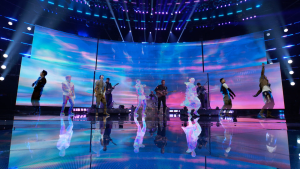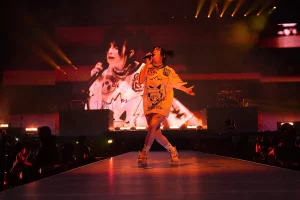Introduction
The landscape of live entertainment is undergoing a seismic shift. With advancements in technology, particularly in augmented reality (AR) and virtual reality (VR), the way we experience concerts and events is transforming at an unprecedented pace. This article delves into the future of live entertainment, focusing on the burgeoning field of virtual concerts and events, and how augmented reality gaming is playing a pivotal role in this evolution.
The Evolution of Live Entertainment

-
Historical Context
Live entertainment has always been a cornerstone of human culture. From ancient amphitheaters to modern stadiums, the desire to gather and experience performances collectively has persisted across millennia. However, the 21st century has introduced new dimensions, driven by technological innovation.
-
The Digital Shift
The internet revolutionized how we consume media, and live entertainment was no exception. Streaming services brought concerts and events into our living rooms, but the experience still lacked the communal and immersive aspects of being physically present. Enter virtual concerts and events, which aim to bridge this gap.
Virtual Concerts and Events: An Overview

-
What Are Virtual Concerts?
Virtual concerts are live performances broad casted over the internet, often featuring interactive elements that allow audiences to engage in ways traditional broadcasts cannot. These concerts can be experienced through various platforms, including social media, dedicated streaming services, and increasingly, through AR and VR technologies.
-
The Role of Augmented Reality
Augmented reality enhances real-world environments by overlaying digital information, creating a composite view that can be interacted with in real-time. In the context of live entertainment, AR can transform a simple concert into an immersive experience, allowing audiences to interact with performers and other attendees in novel ways.
The Intersection of Augmented Reality and Gaming

-
Augmented Reality Gaming: A Primer
Augmented reality gaming involves integrating game visuals and audio content with the user’s environment in real-time. Unlike virtual reality, which creates a completely immersive virtual environment, AR enhances the real world with digital elements. Popular examples include games like Pokémon GO and Harry Potter: Wizards Unite.
-
How AR Gaming Influences Virtual Concerts
The principles of AR gaming are being applied to virtual concerts to create more interactive and engaging experiences. For instance, attendees can use AR to see holographic performers in their living rooms or participate in interactive elements like virtual scavenger hunts during a concert.
Benefits of Virtual Concerts and Events

-
Accessibility
One of the most significant advantages of virtual concerts is accessibility. People from around the world can attend events without the need for travel, reducing both cost and environmental impact.
-
Interactivity
Virtual concerts offer unprecedented levels of interactivity. Fans can choose camera angles, interact with performers through live chats, and even participate in virtual meet-and-greets.
-
Customization
AR allows for a high degree of customization. Attendees can choose how they want to experience the event, whether it’s through a fully immersive AR setup or a more traditional streaming format.
Challenges and Considerations

-
Technical Limitations
While the technology is rapidly advancing, there are still limitations to consider. High-quality AR experiences require robust hardware and fast internet connections, which may not be accessible to everyone.
-
Authenticity
One of the criticisms of virtual concerts is the lack of authenticity. The communal experience of being in a crowd, feeling the energy, and physically seeing the performers is hard to replicate in a virtual setting.
-
Monetization
Monetizing virtual concerts and events poses another challenge. While ticket sales for physical events are straightforward, virtual events often rely on a combination of ticket sales, sponsorships, and in-app purchases, complicating the revenue model.
Case Studies
-
Travis Scott’s Fortnite Concert
One of the most notable examples of a successful virtual concert is Travis Scott’s performance in the video game Fortnite. The event attracted over 12 million concurrent viewers and featured a fully interactive, AR-enhanced experience that set a new benchmark for virtual concerts.
-
Billie Eilish’s AR Concert
Billie Eilish’s AR concert took the concept further by integrating AR elements that allowed fans to interact with the performance in real-time. Using their smartphones, fans could see holographic images and participate in interactive elements, creating a unique and engaging experience.
The Future of Virtual Concerts and Events

-
Technological Advancements
As technology continues to evolve, the quality and accessibility of virtual concerts are expected to improve. Advances in AR and VR, coupled with faster internet speeds and more powerful hardware, will make these experiences more immersive and engaging.
-
Hybrid Events
The future may also see a rise in hybrid events, combining physical and virtual elements. These events can offer the best of both worlds, allowing those who can attend in person to do so while providing a high-quality virtual experience for remote attendees.
-
Augmented Reality Gaming Integration
The integration of augmented reality gaming into virtual concerts is likely to become more sophisticated. Imagine attending a concert where you can participate in an AR game that influences the performance in real-time, creating a dynamic and interactive experience that blurs the line between gaming and live entertainment.
Conclusion
The future of live entertainment is undoubtedly exciting, with virtual concerts and events at the forefront of this transformation. Augmented reality gaming is playing a crucial role in shaping these experiences, offering new levels of interactivity and engagement. While challenges remain, the potential for creating unique, immersive, and accessible experiences is immense. As technology continues to advance, the line between the physical and virtual worlds will continue to blur, redefining what it means to attend a live event.




